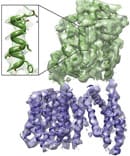Determining Atomic-Resolution Structures Using Electron Cryo-Microscopy

Electron cryo-microscopes have received a much needed update with new detector hardware and image processing software to determine complex molecular structures at resolutions as low as 4.5 Å.
Researchers at the MRC Laboratory of Molecular Biology and Tsinghua University have been able to improve electron cryo microscopes by outfitting detectors with a constant movie recorder and improved image processing software that improves accuracy from 300Å to 4.5Å resolution.
Cryo-EM involves freezing a thin film of water over a sample, and projection of images of multiple copies, at different orientations. A detector records images of the sample with 200 kV to300 kV electron beams. Tens of thousands of images are stitched/aligned together to get a noise free magnification of the molecule in question. The problem with this earlier method was that it was good enough for large molecules but not for smaller ones. The molecules under the electron beam detector are radiation sensitive causing the sample to move. The constant radiation breaks co-valent bonds in the sample, along with other much detrimental gas molecule damages.
The researchers solves this issue by using new more sensitive and much faster direct electron detectors that record at the rate of many frames per second. These movie frames are then analyzed for movements and digitally added to give an extremely sharp, motion corrected magnification. The software works without user intervention making results more repeatable and reliable.
Using the new improved cryo-EM, the researchers successfully magnified the human y-secretase complex, an enzyme of significance in Alzheimer’s. However, researcher are looking at a more promising future or cryo-EM with a resolution of 3 Å and better. Future improvements include much faster readout rates, thinner detector chips, improvements in electron specimen preparation and much better supports.
Cited: eLife 2014;3:e03665 (DOI: http://dx.doi.org/10.7554/eLife.03665)

